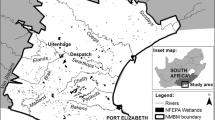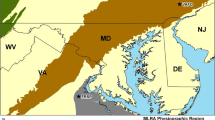Abstract
The extent of wetland in New Zealand has decreased by approximately 90% since European settlement began in 1840. Remaining wetlands continue to be threatened by drainage, weeds, and pest invasion. This article presents a rapid method for broad-scale mapping and prioritising palustrine and estuarine wetlands for conservation. Classes of wetland (lacustrine, estuarine, riverine, marine, and palustrine) were mapped using Landsat ETM+ imagery and centre-points of palustrine and estuarine sites as ancillary data. The results shown are for the Manawatu–Wanganui region, which was found to have 3060 ha of palustrine and 250 ha of estuarine wetlands. To set conservation priorities, landscape indicators were computed from a land-cover map and a digital terrain model. Four global indicators were used (representativeness, area, surrounding naturalness, and connectivity), and each was assigned a value to score wetland sites in the region. The final score is an additive function that weights the relative importance of each indicator (i.e., multicriteria decision analysis). The whole process of mapping and ranking wetlands in the Manawatu–Wanganui region took only 6 weeks. The rapid methodology means that consistent wetland inventories and ranking can now actually be produced at reasonable cost, and conservation resources may therefore be better targeted. With complete inventories and priority lists of wetlands, managers will be able to plan for conservation without having to wait for the collection of detailed biologic information, which may now also be prioritised.




Similar content being viewed by others
References
Anselin A., P. M. Meire, L. Anselin. 1989. Multicriteria techniques in ecological evaluation: an example using the analytical hierarchy process. Biological Conservation 49:215–229
Beinat E. 1997. Value functions for environmental management. Kluwer Academic, Boston, MA, 241 pp
Chopra R., V. K. Verma, P. K. Sharma. 2001. Mapping, monitoring and conservation of Harike wetland ecosystem, Punjab, India, through remote sensing. International Journal of Remote Sensing 22:89–98
Clarkson B. D., D. W. Stephens. 2000. Utility of environmental domains as a framework for assessing representativeness of terrestrial and wetland natural areas. CBER Contract Report 6. Centre for biodiversity and ecology research, Department of Biological Sciences, The University of Waikato, Hamilton, June 2000, 21 pp
Congalton R. G., K. Green. 1999. Assessing the accuracy of remotely sensed data: principles and Practices. Lewis, New York, NY, 137 pp
Coppolillo P. H. G., F. Maisels, R. Wallace. 2004. Selection criteria for suites of landscape species as a basis for site-based conservation. Biological Conservation 115:419–430
Dymond J. R., J. D. Shepherd. 2004. The spatial distribution of indigenous forest and its composition in the Wellington region, New Zealand, from ETM+ satellite imagery. Remote Sensing of Environment 90:116–125
Eyles G. R. J., P. F. Newsome. 1990. A decade of experience using a New Zealand GIS. New Zealand Geographer 46:46–47
Fensham R. J., R. J. Price. 2004. Ranking spring wetlands in the Great Artesian Basin of Australia using endemicity and isolation of plant species. Biological Conservation 119:41–50
Gluck M., R. Rempel, P. W. C. Uhlig. 1996. An evaluation of remote sensing for regional wetland mapping applications. Forest Research Report No. 137. Sault St Marie, Ontario, Canada, 33 pp
Haig S. M., D. W. Mehlman, L. W. Oring. 1998. Avian movements and wetland connectivity in landscape conservation. Conservation Biology 12:749–758
Harvey K. R., J. E. Hill. 2001. Vegetation mapping of a tropical freshwater swamp in the Northern Territory, Australia: a comparison of aerial photography, Landsat TM and SPOT satellite imagery. International Journal of Remote Sensing 22:2911–2925
Henderson F. M., R. Chasan, J. E. Portolese, T. F. Hart Jr. 2002. Evaluation of SAR-optical imagery synthesis techniques in a complex coastal ecosystem. Photogrammetric Engineering and Remote Sensing 68:839–846
Houhoulis P. F., W. K. Michener. 2000. Detecting wetland change: a rule-based approach using NWI and SPOT-XS data. Photogrammetric Engineering and Remote Sensing 66:205–211
Joy M. K. 1999. Freshwater fish community structure in Taranaki: dams, diadromy or habitat quality? Master’s thesis, Massey University, Palmerston North, New Zealand, 97 pp
Kentula M. E. 1997. A comparison of approaches to prioritizing sites for riparian restoration. Restoration Ecology 5:69–74
Kingsford R. T., R. F. Thomas. 2002. Use of satellite image analysis to track wetland loss on the Murrumbidgee River floodplain in arid Australia, 1975−1998. Water Science and Technology 45:45–53
Kingsford R. T., K. Brandis, R. F. Thomas, P. Crighton, E. Knowles, E. Gale. 2004. Classifying landform at broad spatial scales: the distribution and conservation of wetlands in New South Wales, Australia. Marine and Freshwater Research 55:17–31
Klemas V. V. 2001. Remote sensing of landscape-level coastal environmental indicators. Environmental Management 27:47–57
Kushwaha P. S., R. S. Dwivedi, B. R. M. Rao. 2000. Evaluation of various digital image processing techniques for detection of coastal wetlands using ERS-1 SAR data. International Journal of Remote Sensing 21:565–579
Leathwick J. R., J. M. Overton, M. McLeod. 2003. An environmental domain classification of New Zealand and its use as a tool for biodiversity management. Conservation Biology 17:1612–1623
Lee J. T., S. J. Woddy, S. Thompson. 2001. Targeting sites for conservation: using a patch-based ranking scheme to assess conservation potential. Journal of Environmental Management 61:367–380
Lindenmayer D. B., R. B. Cunningham, C. F. Donnelly, R. Lesslie. 2002. On the use of landscape surrogates as ecological indicators in fragmented forests. Forest Ecology and Management 159:203–216
Margules C., R. Pressey. 2000. Systematic conservation planning. Nature 405:243–253
McAllister L. S., B. E. Peniston, S. G. Leibowitz, B. Abbruzzese, J. B. Hyman. 2000. A synoptic assessment for prioritizing wetland restoration efforts to optimize flood attenuation. Wetlands 20:70–83
Ministry for the Environment. 1997. The State of New Zealand’s Environment. Ministry for the Environment, Wellington, New Zealand
Ministry for the Environment. 1998. Environmental performance indicators: proposals for terrestrial and freshwater biodiversity. Ministry for the Environment, Wellington, New Zealand
Mitsch W. J., J. G. Gosselink. 2000. Wetlands, third edition. Wiley, New York, NY
Nelson S. A. C., P. A. Soranno, J. Qi. 2002. Land-cover change in upper Barataria basin estuary, Louisiana, 1972–1992: increases in wetland area. Environmental Management 29:716–727
Ozesmi S. L., M. E. Bauer. 2002. Satellite remote sensing of wetlands. Wetland Ecology and Management 10:381–402
Richardson M. S., R. C. Gatti. 1999. Prioritizing wetland restoration activity within a Wisconsin watershed using GIS modelling. Journal of Soil and Water Conservation 54:537–542
Saaty T. 1977. A scaling method for priorities in hierarchical structures. Journal of Mathematical Psychology 15:234–281
Schmidt K. S., A. K. Skidmore. 2003. Spectral discrimination of vegetation types in a coastal wetland. Remote Sensing of Environment 85:92–108
Shepherd J. D., J. R. Dymond. 2003. Correcting satellite imagery for the variance of reflectance and illumination with topography. International Journal of Remote Sensing 24:3503–3514
Thompson B. C., P. L. Matusik-Rowan, K. G. Boykin. 2002. Prioritizing conservation potential of arid-land montane natural springs and associated riparian areas. Journal of Arid Environments 50:527–547
Turpie J. K. 1995. Prioritizing South African estuaries for conservation: a practical example using waterbirds. Biological Conservation 74:175–185
Turpie J. K., J. B. Adams, A. Joubert, T. D. Harrison, B. M. Colloty, R. C. Maree, A. K. Whitfield, T. H. Wooldridge, S. J. Lamberth, S. Taljaard, et al. 2002. Assessment of the conservation priority status of South African estuaries for use in management and water allocation. Water South Africa (SA) 28:191–206
United Nations Environment Programme/Global Resource Information Database. 1999. Coordinated monitoring of New Zealand wetlands, phase 1: a Ministry for the Environment SMF funded project. Monitoring changes in wetland extent: an environmental performance indicator for wetlands. Global Resource Information Database. UNEP, Christchurch, New Zealand
Vellidis G., M. C. Smith, S. G. Leibowitz, W. B. Ainslie, B. A. Pruitt. 2003. Prioritizing wetland restoration for sediment yield reduction: a conceptual model. Environmental Management 31:301–312
Whaley K. J., B. D. Clarkson, J. R. Leathwick. 1995. Assessment of the criteria used to determine ‘significance’ of natural areas in relation to section 6(c) of the Resource Management Act (1991). Report no LC9596/021. Landcare Research, Lincoln, New Zealand
Wright C. K. 2004. Remote sensing of wetlands in Yellowstone National Park. Doctoral thesis. Montana State University, Bozeman, Montana
Acknowledgments
This research has been funded by the Foundation for Research Science and Technology (grant No C09X0115) and Horizons Regional Council, Palmerston North. We thank O. Ausseil for providing advice and data for this project.
Author information
Authors and Affiliations
Corresponding author
Rights and permissions
About this article
Cite this article
Ausseil, AG.E., Dymond, J.R. & Shepherd, J.D. Rapid Mapping and Prioritisation of Wetland Sites in the Manawatu–Wanganui Region, New Zealand. Environmental Management 39, 316–325 (2007). https://doi.org/10.1007/s00267-005-0223-1
Received:
Accepted:
Published:
Issue Date:
DOI: https://doi.org/10.1007/s00267-005-0223-1




